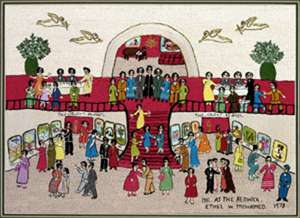Ethel Wright Mohamed
Ethel Wright Mohamed (October 13, 1906 – February 15, 1992) was an American artist, best known for her embroidered scenes of country life. She is sometimes compared to "Grandma Moses," both for her folk art style of illustration and her late start as an artist.[1][2]
Ethel Wright Mohamed | |
|---|---|
 | |
| Born | Ethel Lee Wright October 13, 1906 Webster County, Mississippi |
| Died | February 15, 1992 (aged 85) |
| Nationality | American |
| Known for | Embroidery |
| Movement | Folk Art |
| Spouse(s) | Hassan Mohamed ( m. 1924) |
Early life
Ethel Lee Wright was born on a farm in Webster County, Mississippi, the eldest child of Elijah Wright and Nina Bell Ramsay Wright.[3] She learned to embroider as a child, from her mother. As a teenager she worked at a bakery in Shaw, Mississippi.[4]
Career
Ethel Wright Mohamed returned to embroidery after she was widowed in 1965.[5] "There is just a soothing music as the needle comes through the cloth," she told the Tuscaloosa News in 1992. She embroidered elaborate scenes based on her own memories and family life. Her colorful works found a local audience through family members, and soon they were exhibited in regional museums as folk art.[6] In 1974, her embroidered art was part of the Smithsonian Institution's Festival of American Folklife in Washington D. C. The next year, the Smithsonian commissioned a tapestry by Mohamed, for the Bicentennial Festival of American Folklife, and in 1976-77, twelve works by Mohamed were displayed at the Renwick Gallery. She embroidered a picture of the Renwick event, which is now in the Smithsonian American Art Museum.[7]

In 1977, director William R. Ferris featured Mohamed in the documentary film "Four Women Artists," produced by the Center for Southern Folklore, as one of the four Mississippi women in the title, along with writer Eudora Welty, quilter Pecolia Warner, and painter Theora Hamblett.[8]
Mohamed donated original works to charities and museums, including the American Heart Association and the University of Mississippi Medical Center.[9] She was honored with a Governor's Lifetime Achievement Award for Excellence in the Arts in 1991.[10][11]
Personal life and legacy
Ethel Wright married Lebanese-born salesman Hassan Mohamed in 1924.[12] They had eight children, and lived most of their lives in Belzoni, Mississippi, where they operated the H. Mohamed Store. Ethel ran the store after Hassan's passing, until 1980 when a grandson took over. She died in 1992, age 85.[13]
The Ethel Wright Mohamed Stitchery Museum is open to the public in Mohamed's former home, with her youngest daughter Carol Mohamed Ivy as curator.[14] In 2007, a show of Mohamed's work was mounted at the Lauren Rogers Museum of Art in Laurel, Mississippi.[15]
References
- Mississippi Conservation Center, "Ethel Wright Mohamed Stitchery Museum."
- "Woman Tells Stories with Embroidery," Tuscaloosa News(February 15, 1992): 5B.
- "Mississippi Department of Archives and History, "Mohamed (Ethel Lee Wright) Manuscript."". Archived from the original on 2015-01-03. Retrieved 2015-01-03.
- Christine Wilson, "Ethel Wright Mohamed," in Carol Crown, Cheryl Rivers, and Charles Reagan Wilson, eds. The New Encyclopedia of Southern Culture, volume 23: Folk Art (University of North Carolina Press 2013). ISBN 0807871745
- Willie Morris and David Rae Morris, My Mississippi (University Press of Mississippi 2000): 89. ISBN 1578061938
- "Woman Tells Stories with Embroidery," Tuscaloosa News(February 15, 1992): 5B.
- "Ethel Wright Mohamed, "Me at the Renwick" (1978), Smithsonian American Art Museum". Archived from the original on 2015-01-03. Retrieved 2015-01-03.
- Teri Hurst, "Folk-South: Workshop on Southern Life and Art Tells it Like it Is," Daily News [Bowling Green, Kentucky] (November 9, 1978): 5-A.
- "Woman Tells Stories with Embroidery," Tuscaloosa News(February 15, 1992): 5B.
- "Mississippi Arts Commission, Past Governor's Awards Recipients". Archived from the original on 2015-02-21. Retrieved 2015-01-03.
- "Mississippi Department of Archives and History, "Mohamed (Ethel Lee Wright) Manuscript."". Archived from the original on 2015-01-03. Retrieved 2015-01-03.
- Lu Ann Jones, "Gender, Race, and Itinerant Commerce in the Rural New South," in Pippa Holloway, ed., Other Souths: Diversity and Difference in the U. S. South, Reconstruction to Present (University of Georgia Press 2008): 73. ISBN 0820329843
- Elmo Howell, Mississippi Back Roads: Notes on Literature and History (Roscoe Langford 1998): 25. ISBN 0962202665
- The Ethel Wright Mohamed Stitchery Museum website.
- "The Needle's Song: The Folk Art of Ethel Wright Mohamed," Lauren Rogers Museum of Art, May 10-July 8, 2007.
External links
- Ethel Wright Mohamed, My Life in Pictures (Mississippi Department of Archives and History 2003).
- Ethel Wright Mohamed at Find a Grave